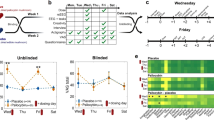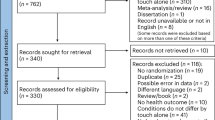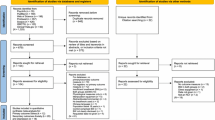Abstract
Since meditative practices are associated with changes that are consistent with decreased activity of the sympathetic nervous system1–7, it is conceivable that measurable body temperature changes accompany advanced meditative states. With the help of H.H. the Dalai Lama, we have investigated such a possibility on three practitioners of the advanced Tibetan Buddhist meditational practice known as g Tum-mo (heat) yoga living in Upper Dharamsala, India. We report here that in a study performed there in February 1981, we found that these subjects exhibited the capacity to increase the temperature of their fingers and toes by as much as 8.3°C.
This is a preview of subscription content, access via your institution
Access options
Subscribe to this journal
Receive 51 print issues and online access
$199.00 per year
only $3.90 per issue
Buy this article
- Purchase on Springer Link
- Instant access to full article PDF
Prices may be subject to local taxes which are calculated during checkout
Similar content being viewed by others
References
Wallace, R. K., Benson, H. & Wilson, A. F. Am. J. Physiol. 221, 795–799 (1971).
Wallace, R. K. & Benson, H. Scient. Am. 226, 84–90 (1972).
Benson, H., Beary, J. F. & Carol, M. P. Psychiatry 37, 37–46 (1974).
Beary, J. F. & Benson, H. Psychosom. Med. 36, 115–120 (1974).
Benson, H., Steinert, R. F., Greenwood, M. M., Klemchuk, H. M. & Peterson, N. H. J. hum. Stress 1, 37–44 (1975).
Benson, H. The Relaxation Response (Collins, London, 1976).
Hoffman, J. W. et al. Science 215, 190–192 (1982).
David-Neel, A. Magic and Mystery in Tibet, 227 (Dover, New York, 1932).
Maslack, C., Marshall, G. & Zimbardo, P. G. Psychophysiology 9, 600–605 (1972).
Roberts, A. H., Kewman, D. G. & MacDonald, H. J. abnorm. Psychol. 82, 163–168 (1973).
Newman, R. W. Am. ind. Hyg. Ass. J. 36, 610–617 (1975).
Lynch, W. C., Hama, H., Kohn, S. & Miller, N. E. Psychophysiology 13, 219–221 (1976).
Taub, E. & Emurian, C. S. Biofeedback Self-Regulation 1, 147–168 (1976).
Jacobson, A. M., Manschreck, T. C. & Silverberg, E. Am. J. Psychiat. 136, 844–846 (1979).
Hatfield, J. A. Lancet ii, 68–69 (1917).
Jevning, R., Wilson, A. F., Smith, W. R. & Morton, M. E. Am. J. Physiol. 235, R89–92 (1978).
Author information
Authors and Affiliations
Rights and permissions
About this article
Cite this article
Benson, H., Lehmann, J., Malhotra, M. et al. Body temperature changes during the practice of g Tum-mo yoga. Nature 295, 234–236 (1982). https://doi.org/10.1038/295234a0
Received:
Accepted:
Issue Date:
DOI: https://doi.org/10.1038/295234a0
This article is cited by
-
Enhancing Human Cognition Through Vajrayana Practices
Journal of Religion and Health (2019)
-
Every breath you take: physiology and the ecology of knowing in meditative practice
International Journal of Dharma Studies (2017)
-
Mindfulness Contextualized: An Integration of Buddhist and Neuropsychological Approaches to Cognition
Mindfulness (2015)
-
Assumptions and Conclusions: Fundamental Distinctions Between Tibetan Buddhist and Western Approaches to Happiness
Journal of Rational-Emotive & Cognitive-Behavior Therapy (2015)
-
An evaluation of the ability to voluntarily reduce the heart rate after a month of yoga practice
Integrative Physiological & Behavioral Science (2004)
Comments
By submitting a comment you agree to abide by our Terms and Community Guidelines. If you find something abusive or that does not comply with our terms or guidelines please flag it as inappropriate.



